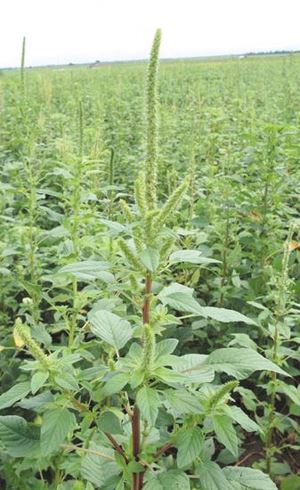Pesky Palmer Pigweed Proliferates
Pesky Palmer Pigweed ProliferatesIt's become the No. 1 bad weed to watch in Missouri.
COLUMBIA, MO.
There's a new No. 1 bad weed to watch in Missouri, says Kevin Bradley, University of Missouri Extension weed specialist.
Palmer pigweed, aka Palmer amaranth, acts bad in more ways than most, Bradley adds.
“The weed pest has been in the state for as long as I’ve been here
(10 years),” Bradley says. It was just another weed, not noteworthy.
However, three years ago that changed when Palmer became resistant to
glyphosate herbicide, the most-used weed control in the state.
Palmer turned aggressive and worked its way from the Bootheel to
northwestern Missouri. For now it's found mainly in counties along the
Mississippi and Missouri rivers.

Palmer pigweed is the new No. 1 bad weed to watch in Missouri.
Photo credit: University of Missouri
Soybean growers in particular face a challenge from the weed, which brings multiple threats, Bradley says.
For starters, each weed produces about 300,000 seeds. Worse, the herbicide resistance is transmitted by pollen.
Unlike most weeds, male and female Palmer pigweed plants are
separate. Pollen must travel through the air to fertilize the flowers
that produce the seeds. A characteristic of the pigweeds is the tall
flower stalks with hundreds of florets.
There’s more. Palmer germinates from early spring until late in the
growing season. “It just doesn’t stop reproducing,” Bradley says. That
allows it to outlast the longest-lasting residual herbicides.
The plant grows fast, up to 2.5 inches a day. And it grows tall, taking over a soybean field by shading out the crop.
Only 2.5 plants per foot of row can hide a growing soybean crop.
Bradley shows slides of soybean fields where you must look close to see a
soybean plant.
No other weed has so many bad things going for it, Bradley says. Control requires constant intensive management.
As with most weeds, but especially Palmer pigweed, the days of “one spray one day and done” are long gone.
Palmer resists glyphosate and four other herbicide modes of action. In Missouri, Palmer is resistant only to glyphosate.
In spite of resistance, producers can control the pest. “It just
takes lots of work,” Bradley told the MU Crop Management Conference.
“When I see growers using crews of choppers with hoes, I know they
understand this is one tough weed.”
Another slide shows workers with pitchforks gathering chopped weeds. Weeds, and seed heads, are hauled from the field.
Palmer pigweed has weaknesses. The seed doesn’t survive for decades
in the soil bank, as some do. When buried deep, the seeds don't come up.
Bradley only suggests plowing deep to bury seed on level, non-erodible
fields.
The seedlings are susceptible to herbicides, but they must be sprayed early. If spayed late, the weeds escape death.
“It’s a serious weed threat and takes serious management,” Bradley
says. “But it can be controlled with extra work and expense.”
Controlling early before seed-set pays off. First priority is to prevent seed production and building a seed bank.
Narrower soybean row-width helps control pigweeds. Drilled beans have
fewer pigweeds as shade covers the ground earlier. More weeds are found
in 30-inch rows.
Increasing seed planting rates boosts odds in favor of the soybean over pigweed seedlings.
Herbicides give control, but lax management won’t work with the
rapidly growing Palmer pigweeds. The seedlings quickly accumulate
growth, requiring more herbicide. Palmer produces up to 65 percent more
dry matter after two weeks than other weed species.
With more foliage, it’s hard to get enough ingredient on the plants.
More than one herbicide mode of action is a must. For that, Bradley
recommends “overlapping residuals.” That leaves less time for the
continuation germination of the Palmer pigweed.
Using just one mode leads to resistance. “I visualize how Palmer
pigweeds became resistant to glyphosate,” Bradley says. “Someone used
only that herbicide season after season.”
Liberty herbicide mode of action still works, he says. “But with
abuse, we lose it.” He says Liberty must be used with a pre-emergent
residual herbicide. And the Liberty application must be timely at early
seedling stage.
Palmer pigweed looks much like other pigweeds, except the stems and
leaves are smooth. Flowering heads are elongated and the plants are
taller.
Bradley maintains a website for weed identification at weedID.missouri.edu.∆